They say… 
Best beer and travel writing award 2015, 2011 -- British Guild of Beer Writers Awards
Accredited Beer Sommelier
Writer of "Probably the best book about beer in London" - Londonist
"A necessity if you're a beer geek travelling to London town" - Beer Advocate
"A joy to read" - Roger Protz
"Very authoritative" - Tim Webb.
"One of the top beer writers in the UK" - Mark Dredge.
"A beer guru" - Popbitch.

|
ABV: 4.5%
Origin: Stoke-on-Trent, Staffordshire, England
Website www.titanicbrewery.co.uk
Originally published in BEER October 2007 as part of a review of that year’s Champion Bottle Conditioned Beer of Britain winners. For more see previous post.
CAMRA North London tasting February 2010
 Titanic Stout With its joint silver medal, Titanic Stout secured a place in the top three for the fourth consecutive year this year, continuing a run which began when it took the gold in 2004. It’s a noteworthy achievement that speaks volumes for the consistent quality of this well-known and well-loved micro based at Burslem, Stoke-on-Trent.
Notably only roasted barley is added to pale malt to darken this beer near-black, with wheat malt to help give a thick pillowy fawn head. A smoky aroma has coffee and blackcurrant yoghurt notes with emerging spiciness. There’s plenty of roast on the palate too, sweetened just enough by slightly caramel-laced malt with hints of liquorice, tangy fruit and cola.
A refreshing swallow leads to a tongue-puckering finish mainly dried by smoky, ashy flavours but developing burry hops with fleeting traces of sweetish malt. Titanic’s name nods to the fact that the captain of the doomed transatlantic liner hailed from the Potteries, but with quality like this it should prove genuinely unsinkable.
For more Champion Bottle Conditioned Beer of Britain winners, see next post.
Read more about this beer at ratebeer.com: http://www.ratebeer.com/beer/titanic-stout/5758/
ABV: 4.8%
Origin: Whimple, Devon, England
Website www.ohanlons.co.uk
Originally published in BEER October 2007
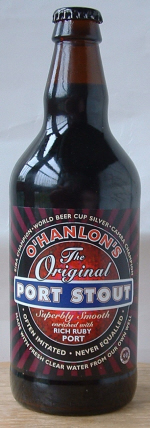 O'Hanlon's Original Port Stout Lovers of the darker side of brewing had cause to smile at the results of this year’s Champion Beer of Britain competition – not only did a dark mild emerge as supreme champion among the cask beers, but three of the four medals awarded in the Real Ale in a Bottle category, including the gold, went to a handsome trio of stouts.
All three are smooth, dry stouts with the bite of roasted barley, designed at least in part to fill the sizeable hole left by the sad decline of bottled Guinness. At the inception of CAMRA, standard bottled Guinness from the Irish giant’s Park Royal plant was one of only five British-brewed bottle conditioned beers.
Park Royal is now flats and business units, and the bottled Guinness “Original” brewed in Dublin for the British market is pasteurised, a pale shadow of its former self in character if not in colour. But if you’re a former Guinness drinker still wallowing in nostalgia and despair, one of these superb beers should soon snap you out of it.
O’Hanlon’s has a name well-suited to a brewer famed for dry stout, but though co-founder John O’Hanlon has Irish roots, the brewery itself started at Vauxhall, London, before being transplanted to rural Devon, where it’s since blossomed into one of Britain’s best speciality breweries.
Original Port Stout, which began as a cask speciality, is no stranger to CBoB success, having previously won gold in 2003. Allegedly based on a Dublin hangover cure, this year’s champion bottle conditioned beer adds a twist by dosing a good dry stout – made from Optic pale, crystal and caramalts, roasted and flaked barley and Phoenix and Styrian Goldings hops – with Ferreira port at the rate of two bottles per barrel, roughly equivalent to two teaspoons per litre.
The result is a very dark ruby brown beer with a creamy yellowish head and a fresh chocolatey and malty aroma that brings to mind a German dunkel, but with a spicy, fruity and winy note. The rich fruity palate has geranium, treacle toffee and slightly peppery herbal flavours.
True to style, a distinct roast flavour soon emerges, and hops supplement the roasty dryness in a smooth winy finish with late bitter chocolate and a hint of cedar smoke. The port isn’t an empty gimmick – it enriches and complements an already superbly made beer with subtle wine and fruit notes.
For more Champion Bottle Conditioned Beer of Britain winners, see next post.
Read more about this beer at ratebeer.com: http://www.ratebeer.com/beer/ohanlons-original-port-stout/11452/
ABV: 8%
Origin: Alva, Clackmannanshire, Scotland
Website: www.harviestoun.com
A shorter version was originally published in BEER November 2008. For more smoky beers see previous post.
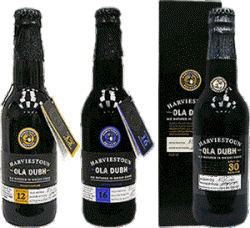 Harviestoun Ola Dubh Special Reserve For a fine but mellow lightly charred experience I recommend Harviestoun Ola Dubh Special Reserve – not bottle conditioned but currently one of Britain’s most remarkable beers. It’s a version of the Clackmannanshire brewery’s Old Engine Oil (the name means “black oil” in Gaelic) matured in wooden casks previously used for Highland Park malt whisky, itself one of the top rated of world whiskies.
There are three “expressions” matured in casks previously used to hold malts of different ages, and they make for a fascinating compare and contrast. The “youngest” is from a 12 year old cask, a black beer with a creamy brown head and a woody whiskyish aroma with a hint of olives over dark malt. There’s thick chocolate and malt flavours on the soft and luscious palate, with a woody background and lightly vinous notes, toffee and woody dryness. More whisky is revealed in the swallow, and the finish is warming with more chocolate, chewy malt, a note of hops and a final impression of charred tanginess.
My favourite is the balanced yet complex example from a 16-year-old cask – a viscous black liquid with a fine deep fawn head and dark malt, wood and black cherry fruit as well as a whiff of whisky on the aroma. There’s chocolate and wood on the palate with a lightly vinous sharpish note, and tangy slightly warming alcohol on the finish with sherry, more chocolate, charred flavours and late but long hop tones.
Finally, the 30-year-old is a very dark ruby black with some fine fawn head and a vinous fruit cake aroma from which emerges big plummy malt notes and that familiar whiff of the water of life. The palate is full and malty with a gentle canided peel note and subtle whisky, perhaps more fruity and less chocolatey than the other versions. A fruity finish has woody dryness and smooth malt, with bitter green herbs and roast notes eventually emerging.
Most of the first batch has gone to the USA but if you spot one on UK shelves, grab it unhesitatingly. You could round off your quest for smoky flavours by lighting up a good cigar to accompany it – so long as you’re not in enclosed public premises, of course.
Read more about these beers (including my own tasting notes) at ratebeer.com:
http://www.ratebeer.com/beer/harviestoun-ola-dubh-12-year-old/84035/
http://www.ratebeer.com/beer/harviestoun-ola-dubh-16-year-old/84058/
http://www.ratebeer.com/beer/harviestoun-ola-dubh-30-year-old/84059/
ABV: 3.5%
Origin: Wrecsam, Cymru
Website: www.jollybrewer.co.uk
A shorter version was originally published in BEER November 2008. For more smoky beers see previous post.
Top Tastings 2008. A shorter version also published on facebook January 2009.
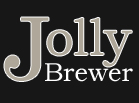 Jolly Brewer Roasted unmalted barley lends an unmistakeable sharp roasty bite to Irish-style dry stouts. A distinctive example is Jolly Brewer Suzanne’s Stout from a tiny but delightful craft brewery in Wrexham. The recipe also includes pale barley malt, flaked barley and Target and Goldings hops.
Beneath the deep fawn head this seriously dry near black beer is has a nutty roasted barley, fruit cake and cough sweet aroma and a light-textured but full dry roasty rye bread palate with notes of rooty dry herbs and toasted vine fruit. Hops emerge over the estery swallow, leading to a dry bitter chocolate finish with caramel and pepper. . Overall this is a beer packed with flavour but with the drinkable lightness that comes with being a surprisingly modest 3.5 per cent ABV.
For more smoky beers, see next post.
Read more about this beer at ratebeer.com: http://www.ratebeer.com/beer/jolly-brewer-suzannes-stout/87308/
ABV: 9%
Origin: Bowburn, Durham, England
Website: www.durham-brewery.co.uk
A shorter version was originally published in BEER November 2008. For more smoky beers see previous post.
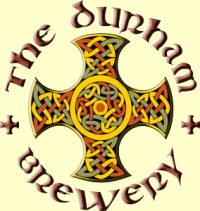 Durham Brewery Also amber (like St Austell Admiral’s Ale — see previous post) but considerably stronger is Durham Bede’s Chalice (9 per cent) one of several fine strong ales perfect for winter drinking from a brewery that emphasises the ecclesiastical heritage of its home territory. It was originally a Christmas beer and is still only bottled on an occasional basis (my tasting sample was from Gyle 1771), but is well worth snapping up if you see it. The grist is Maris Otter pale, lager, Vienna and wheat malts, hopped with Centennial, with a recommended serving temperature of at least 8°C.
It’s a warm amber beer, a glow no doubt down to the Vienna malt, with a fine white head and a smooth and slightly wheaty aroma with notes of angelica and a touch of wood. The palate is rich with orange and peach liqeur character and a spicy wheaty note, with the syrupiness drying on the swallow. A sweet-sour creamy and herby finish develops rooty woody hops and juicy fruit. Overall a very flavourful and impressive beer.
For more smoky beers, see next post.
Read more about this beer at ratebeer.com: http://www.ratebeer.com/beer/durham-bedes-chalice/82045/
ABV: 5%
Origin: St Austell, Cornwall, England
Website: www.staustellbrewery.co.uk
A shorter version was originally published in BEER November 2008. For more smoky beers see previous post. See also Top Tastings 2008.
CAMRA North London tasting February 2010
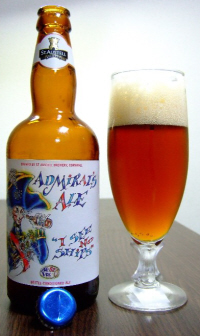 St Austell Admiral's Ale For a more subtle whiff of the bonfire (than Heller Aecht Schlenkerla Rauchbier Weizen – see above), alongside generous and satisfying fruit and biscuity malt flavours, try St Austell Admiral’s Ale, brewed uniquely from Cornish Gold malt which is kilned for the brewery using a special process, making it possible to obtain a rich colour and nutty flavour from a single malt rather than mixing pale and coloured malts as in most amber beers. Hops are Styrian Goldings and Cascade. It was originally developed in 2005 to mark the 200th anniversary of the Battle of Trafalgar.
The beer is a cherry red-brown colour with a little off-white head. A humbug, burnt toffee and malted milk biscuit aroma with a spicy blackcurrant note heralds a full toffee palate with fruity complexity, with vanilla wafer, nuts, liquorice and thick hops emerging. The beer turns tangy towards a drying fruity nutty finish with a subtle roast note. A unique, very juicy and distinctive beer.
For more smoky beers, see next post.
Read more about this beer at ratebeer.com: http://www.ratebeer.com/beer/st-austell-admirals-ale/54788/
ABV: 5.2%
Origin: Bamberg, Franken (Bayern), Germany
Website: www.schlenkerla.de
A shorter version was originally published in BEER November 2008.
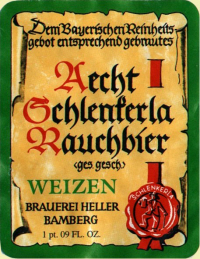 Heller Aecht Schlenkerla Rauchbier Weizen Global warming may have turned late autumn into a balmy season that fools trees into staying up past their bedtime, but according to my childhood programming the cold begins in November, when the half of your body turned towards the Guy Fawkes bonfire toasts while the other half freezes. Smoky bonfires should herald long evenings around roaring log fires, with a beer or two to warm the spirits further.
Smoke and ash are old-established colours on the brewer’s palette: indeed all beers would have had a smoky tang in the days when malt was kilned over wood. Beers made with deliberately smoked malt are still a speciality of Bamberg in Franconia: most examples are filtered, but Heller Aecht Schlenkerla Rauchbier Weizen (5.2 per cent) is a cloudy wheat beer from the bigger of the city’s two smoked beer breweries, made using the brewery’s own beechwood-smoked wheat and barley malt and Hallertauer hops.
This is a cloudy deep brownish amber beer with a thick foamy head and a spicy phenolic aroma with restrained smoke. The palate is well balanced and complex with dried banana flavours leading, followed by lots of smoke and burnt rubber notes over smooth bready malt with spiced apple complexity. A dry hoppy finish has tangy apple fruit and more chewy smoke. The soft wheaty flavours make this possibly an easier entry point into the style than the full-on 100% barley malt versions.
For more smoky beers, see next post.
Read more about this beer at ratebeer.com: http://www.ratebeer.com/beer/aecht-schlenkerla-rauchbier-weizen/8565/
ABV: 5.3%
Origin: Newton Abbot, Devon, England
Website: www.tuckersonline.co.uk
Originally published in BEER May 2007. For more bottled milds see previous post
 Teignworthy Martha's Mild Tucker’s Maltings of Newton Abbot is one of Britain’s few surviving specialist maltings. The building is now a major tourist attraction as well as a working maltings, and hosts both its own beer shop and a brewery.
The Teignworthy Brewery is independently run by former Oakhill brewer John Lawton but maintains a close working relationship with its host including using Tucker’s malts. A wide range of real ales in a bottle includes a number of beers in historic styles.
Martha’s Mild was named to celebrate the birth baby Martha in 2002, but it’s also filled a gap left on the shelves of the maltings beer shop by the disappearance of bottled Dark Ruby. It’s brewed from pale, crystal, amber and chocolate malts, wheat malt and Fuggles and Goldings hops.
The deep reddish brown beer has a restrained malt, fruit and cola aroma with a hint of cough candy. The palate is dryish but with a good dose of fruit that turns slightly tropical, with notes of liquorice, roast malt, minerals and hops.
The finish has cola, melon, roast coffee and a firm dry chocolate bite – perhaps a little stern for a mild and certainly not as sweet as the label claims, but with plenty of quality and distinction. Martha should feel duly honoured.
This beer also featured in a shorter review in BEER March 2009, as one of several milds for May. For the previous mild in this piece, see Vale Black Swan.
Teignworthy Martha’s Mild (5.5 per cent) from Tuckers Maltings, Newton Abbot, Devon, is another ratebeer top 10 entry. Launched in 2002 to celebrate the birth of the brewer’s daughter Martha, this is a dark red-brown beer with notes of cough candy, liquorice, cola and melon, with a rather stern and ashy coffee finish.
The next mild featured in this piece is Hoggleys Mill Lane Mild.
Read more about this beer at ratebeer.com: http://www.ratebeer.com/beer/teignworthy-marthas-mild/22001/
ABV: 4%
Origin: Kislingbury, Northamptonshire, England
Website www.hoggleys.co.uk
Originally published in BEER May 2007. For more bottled milds see previous post.
CAMRA North London tasting 2010
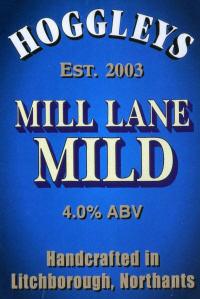 Hoggleys Mill Lane Mild Meanwhile if Sarah Hughes Dark Ruby (see previous post) remains impossible to obtain, there are an increasing number of other good bottle conditioned milds to console yourself with, including this one from a relatively new micro in a village west of Northampton that has just started bottle conditioning after success with cask.
Hoggleys, opened in 2003 by former home brewer Roy Crutchley with Julie Hogg (thus the name), proclaims itself dedicated to quality, and it certainly shows in Mill Lane Mild, brewed from mild, crystal, black and chocolate malts, torrefied wheat and Challenger and Fuggles hops.
At 4 per cent it’s strongish rather than strong, and pours a very dark brown, almost black until held to the light, with a mushroom coloured head. Pastilley malt, roast coffee and sharpish fruit make for an inviting aroma.
A complex palate has dark fruit, malted milk, spice, chocolate and a faint hint of burnt rubber. The roasty finish turns powdery dry with emerging hops, ash and coffee.
It’s on the dry side compared to more traditional milds – a common trait in more recent interpretations – but you can’t fault the quality and richness of flavour, particularly if, as the bottle advises, it’s drunk at room temperature.
This beer also featured as a mild for May in BEER May 2009 in a much shorter review. For the previous review in this piece, see Teignworthy Martha’s Mild.
Hoggleys at Litchborough, Northamptonshire, once claimed to be the smallest brewery in Britain but has since expanded to more commercial proportions, thanks to the sort of quality evident in Hoggleys Mill Lane Mild (4 per cent), a very dark, creamy and pastilley example with blackcurrant, coffee and burnt rubber notes, its roasty bite soothed by a lovely malted milk texture.
For the final beer reviewed in this piece, see Tryst Brockville Dark.
Postscript: I featured this beer at a tasting hosted for North London CAMRA in February 2010 to much appreciation from the attendees, some of whom including a couple of CAMRA veterans had never heard of it. The beer was an easy second favourite (after Fuller’s Vintage Ale and in stiff competition with some former Champion Bottled Beer of Britain winners), reinforcing my admiration for the Hoggleys and their craft.
Read more about this beer at ratebeer.com: http://www.ratebeer.com/beer/hoggleys-mill-lane-mild/54708/
See next post for more bottled milds.
ABV: 6%
Origin: Sedgley, West Midlands, England
Website: www.sarahhughesbrewery.co.uk
Originally published in BEER May 2007
Preface (March 2010):
 Sarah Hughes Dark Ruby The Beacon Hotel brewpub on the outskirts of Sedgley, deep in the Black Country near Wolverhampton and Dudley, may be an unlikely home to a world classic, but its Sarah Hughes Dark Ruby mild is arguably the benchmark of this traditional style. Originally revived as a cask beer in the pub, in the late 1990s it was briefly available more widely in bottle conditioned form, but the contract bottler went out of business and the brewery failed to arrange a replacement. Ever since I’d started writing my CAMRA column I’d always made a point of featuring milds in May to link with CAMRA’s Mild Month campaign aimed at bolstering what at one point seemed a fast disappearing style: Dark Ruby was always top of my list, and every year I’d doggedly pester the brewery for news of the bottled version.
My efforts were in vain until in 2007 I was told bottling was likely to restart soon if there was a demand – the brewer had even carried out some tests and sent me two bottles for review. Tasting one, I was so excited I decided to break my normal rule of only writing about currently available bottled beers, and used Dark Ruby to lead that May’s column.
Almost three years on I’m sad to say there’s still no sign of bottled Dark Ruby, though the cask version continues to be available at the pub and leaks out occasionally to a few free houses and festivals. Meanwhile I stashed my second sample bottle away to see what became of it with age, and finally cracked it open this winter. What follows is the text of my original piece, and appended are some tasting notes on the aged bottle. Two other bottled milds featured in May 2007 appear in succeeding posts.
Original review:
Around the world there are a few beers that every dedicated beer lover ought to try at least once, not just for their intrinsic quality but also their deep links to the heritage of brewing. Consider the likes of Worthington White Shield, Anchor Steam, Guinness Foreign Extra, Budvar and most of the Trappist ales – beers so precious, UNESCO should slap a World Heritage designation on them.
One deserving entrant on this list originates from a small brewpub in the little-known town of Sedgley, a bus ride from Wolverhampton in the Black Country of the English West Midlands. The Beacon Hotel is a gem of a pub, listed in CAMRA’s National Inventory for preserving its multi-roomed layout, but perhaps most celebrated as the home of Sarah Hughes Dark Ruby Mild.
The hotel and its brewery date from 1850, and Sarah Hughes herself presided for 50 years from 1921. The brewery fell out of use in the late 1950s but was revived in 1987 by Sarah’s grandson, John Hughes, who still owns the pub today.
John dug his grandmother’s recipe out of a bank vault and resolved to stick to it as closely as possible, recreating an authentic strong early 20th century Black Country mild of the sort that once slaked the thirst of local workers in the days when this area earned its uninviting name from the smoke of a thousand factory chimneys.
Dark Ruby is originally a cask beer, but its robust strength and character make it ideal for the bottle. A bottle conditioned version helped spread the beer’s reputation for a while, but then the contract bottler went out of business, and the brewery never found the time to sort out a replacement.
Recently bottling has been back on the agenda at the Beacon, and head brewer Andrew Brough has produced a number of test brews. When my colleague Jeff Evans reviewed a sample in Beers of the World magazine, hinting that regular bottling would resume shortly, the brewery was overwhelmed by enquiries.
The truth is that there are no finalised arrangements for commercial bottling yet, but the more interest generated in the beer, the more confident they’ll feel about making the investment. That’s partly why for this year’s Mild Month I’m ignoring my usual rule of sticking to easily available beers by featuring a rare test bottling.
The beer is brewed from Maris Otter pale and crystal malts, caramel, invert sugar and a very traditional blend of Fuggles and Goldings hops. The result is indeed a rich dark ruby brown, with a creamy yellow head.
A very fruity aroma of blackcurrants, overripe plums and fruit cake has a distinctive sharpish note. The palate is nicely sweet and fruity at first, but firm burry hop and roast notes add plenty of backbone.
A long finish has more fruit, moreishly drying but not particularly bitter hops and a late tarry touch. Overall it’s a luxurious and grownup beer without the forward smoky roast flavours with which many modern micros now dose their dark milds.
The beer’s pleasures deserve to be shared with the millions of potential devotees who will never get a chance to catch that bus from Wolverhampton. The Campaign for Real Dark Ruby in a Bottle starts here.
Tasting notes on aged bottle, bottled early 2007, tasted December 2009.
A very dark and slightly hazy ruby beer that pours with a thick, fine and creamy yellow-orange head yielding a mature marmalade aroma with notes of brown sugar, herbs and ripe fruit. The complex malt palate has thinned and developed oxidised Madeira notes with minty marmalade, cherryish port wine and brown sugar, and very mild hops: the hop and roast characteristics noted in the younger beer have certainly mellowed out. A fruity cherry finish has caramel, port, light woody tones and a slight alcoholic kick. Perhaps aged a little too long and starting to turn a bit papery, not as spectacular as the younger beer but still interesting and complex.
See next post for more bottled milds.
Read more about this beer at ratebeer.com: http://www.ratebeer.com/beer/sarah-hughes-dark-ruby-mild/5113/
|
Cask  This pioneering new book explains what makes cask beer so special, and explores its past, present and future. Order now from CAMRA Books. Read more here. This pioneering new book explains what makes cask beer so special, and explores its past, present and future. Order now from CAMRA Books. Read more here.
London’s Best Beer  The fully updated 3rd edition of my essential award-winning guide to London’s vibrant beer scene is available now from CAMRA Books. Read more here. The fully updated 3rd edition of my essential award-winning guide to London’s vibrant beer scene is available now from CAMRA Books. Read more here.
|














